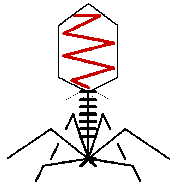
Endonuclease VII
Gene 49 Controls DNA Packaging
A brief historical review part I
1966 Luftig and coworkers demonstrated that the empty appearing heads in gene 16- and 17- infections were indeed completely empty, while the heads in 49- infections were partly filled (Luftig & Ganz 1971). This classified mutations in genes 16 and 17 as packaging initiation deficient and mutations in gene 49 as packaging continuation deficient. Frankel who studied DNA replication in these mutants found that the precursor DNAs in 16-/17- infections were markedly different from the DNA in 49- infections (Frankel 1969). He described an unusual stabiltiy of an unusual compact precursor DNA in 49- infections as the result of an accumulation of uncleaved (recombinational?) branches. He suggested that the product of gene 49 (gp49) was a nuclease specific for resolving these hypothesized branches.
1976 Ultimate proof for this view was given by Kemper et al who
demonstrated that in 49- infections heads were indeed begun to be filled
but resent complete packaging because of branches in the DNA blocking further
translocation of the DNA into the heads due to obstructing branches (Kemper
& Brown 1976).
Review
part II